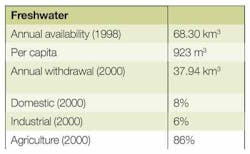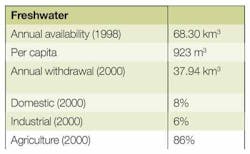Considering Dynamic Seals to Address Shaft Sealing Problems
By Allan R. Budris
The number one cause of pump downtime is failure of the shaft seal, and wastewater applications with varied solids content provide a special challenge.
On some tough pumping services like wastewater, mechanical seals require outside flush and constant, costly attention. Even then, unless superior seals and seal support systems are employed in conjunction with steeply tapered and grooved seal housings, seal failures are common, resulting in downtime. Dynamic seals, which use a repeller, or dynamic seal, between the stuffing box and impeller, may be a good alternative for a mechanical seal in certain water-based services.
Dynamic Seals
A "Repeller", or dynamic seal, works like a small backwards pumping impeller. It offers longer life than mechanical seals on abrasive applications, but is sensitive to the suction pressure. Also, the secondary seals that handle shaft sealing with a repeller, when the unit is shut down, are not normally as good as a mechanical seal. This means that repellers are not good for toxic / hazardous applications. They also consume more power than a mechanical seal.
A repeller (sometimes called "expeller"), works much like a small impeller. At start-up the repeller pumps liquid and solids from the stuffing box. The repeller soon becomes air-bound and an interface forms within the repeller vanes, sealing the pumped liquid. When the pump is shut down, packing or some more advanced type of secondary seal prevents the pumpage from leaking into the ambient environment. The advantages of a dynamic seal include:
- External seal water is not required
- Elimination of pumpage contamination and product dilution
- No need to treat seal water
- Eliminating problems associated with piping from a remote source.
There are, however, also some disadvantages with a dynamic seal, which include:
- The repeller / expeller consumes a fair amount of power. It is basically a small impeller operating at shut-off.
- The secondary seal does not typically seal as well as a mechanical seal when the pump is shut down.
- Dynamic seals are limited to relatively low suction pressures. If the suction pressure is too high the required "liquid – gas" interface will be forced to the secondary seal, which will shorten the life of the secondary seal. When the pump is at rest the suction pressure should also be limited (to around 15 psig) to prevent abrasives from being forced into the secondary seal).
- The maximum allowable suction pressure is further reduced with variable speed applications, because slower speeds will reduce the sealing pressure generated by the expeller.
Mechanical Seal / Packing Lubrication
Traditional packing and mechanical seals both require clean water for the lubrication of the packing or the seal faces. Finding clean water in a sewage plant can be difficult, and even when available it may be inadvisable to hook up a potable or non potable water line to a sewage pump. This is due to the fact that the sewage water may flow backward in case of a power failure, by malfunctions, or there may be an interruption of the clean water pump. When a plant water supply is used for sealing purposes, an air gap between the incoming water supply and seal water system is required to prevent contamination. Hence, sewage plants often use an independent seal water system. This seal water system normally consists of a tank with overflow connections and a float to maintain the air gap, two small pumps with duplex control panel "Y" strainer, relief valves and isolation valves. The cost of such a seal water system with installation and piping cost can range from $10,000 to $20,000.
In addition to the cost of a separate sealing system, the sewage plant also has to consider power to run the seal water pump and the cost of clean water. A 4x4 sewage pump with 2' sleeve OD can consume 0.5 gpm to 2.5 gpm, depending on packing type and lantern ring position. On the other hand, a single mechanical seal can also consume 0.5 gpm to 1.5 gpm of flush water. This means if the pump runs for 24 hours a day, the total consumption of sealing water for just one 4x4 pump can be as high as 1000 to 2500 tons of water per year. Since the sealing water travels back to the process, the 1000 to 2500 tons of extra water will need to be treated again before it returns to the environment.
Conclusion
So the question becomes, if the suction pressure is low enough, can the extra power consumed by the expeller be justified by the cost and complexity of a flush water support system for a mechanical seal assembly? Or, do mechanical seals just not stand up to the sealing challenges of the system.
More WaterWorld Current Issue Articles
More WaterWorld Archives Issue Articles


